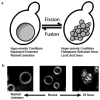Target of rapamycin signaling mediates vacuolar fragmentation
- PMID: 27233284
- PMCID: PMC5124550
- DOI: 10.1007/s00294-016-0616-0
Target of rapamycin signaling mediates vacuolar fragmentation
Abstract
In eukaryotic cells, cellular homeostasis requires that different organelles respond to intracellular as well as environmental signals and modulate their behavior as conditions demand. Understanding the molecular mechanisms required for these changes remains an outstanding goal. One such organelle is the lysosome/vacuole, which undergoes alterations in size and number in response to environmental and physiological stimuli. Changes in the morphology of this organelle are mediated in part by the equilibrium between fusion and fission processes. While the fusion of the yeast vacuole has been studied intensively, the regulation of vacuolar fission remains poorly characterized by comparison. In recent years, a number of studies have incorporated genome-wide visual screens and high-throughput microscopy to identify factors required for vacuolar fission in response to diverse cellular insults, including hyperosmotic and endoplasmic reticulum stress. Available evidence now demonstrates that the rapamycin-sensitive TOR network, a master regulator of cell growth, is required for vacuolar fragmentation in response to stress. Importantly, many of the genes identified in these studies provide new insights into potential links between the vacuolar fission machinery and TOR signaling. Together these advances both extend our understanding of the regulation of vacuolar fragmentation in yeast as well as underscore the role of analogous events in mammalian cells.
Keywords: ER stress; TORC1; Vacuolar fission.
Figures



References
-
- Bachhawat AK, Manolson MF, Murdock DG, Garman JD, Jones EW. The VPH2 gene encodes a 25 kDa protein required for activity of the yeast vacuolar H(+)-ATPase. Yeast. 1993;9:175–184. - PubMed
Publication types
MeSH terms
Substances
Grants and funding
LinkOut - more resources
Full Text Sources
Other Literature Sources
Molecular Biology Databases

